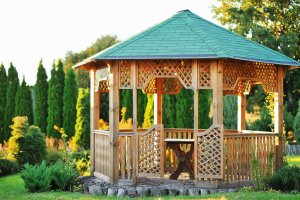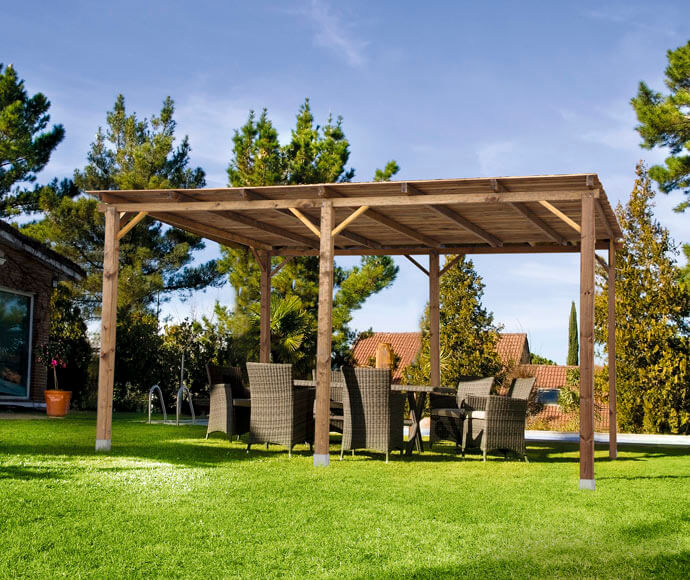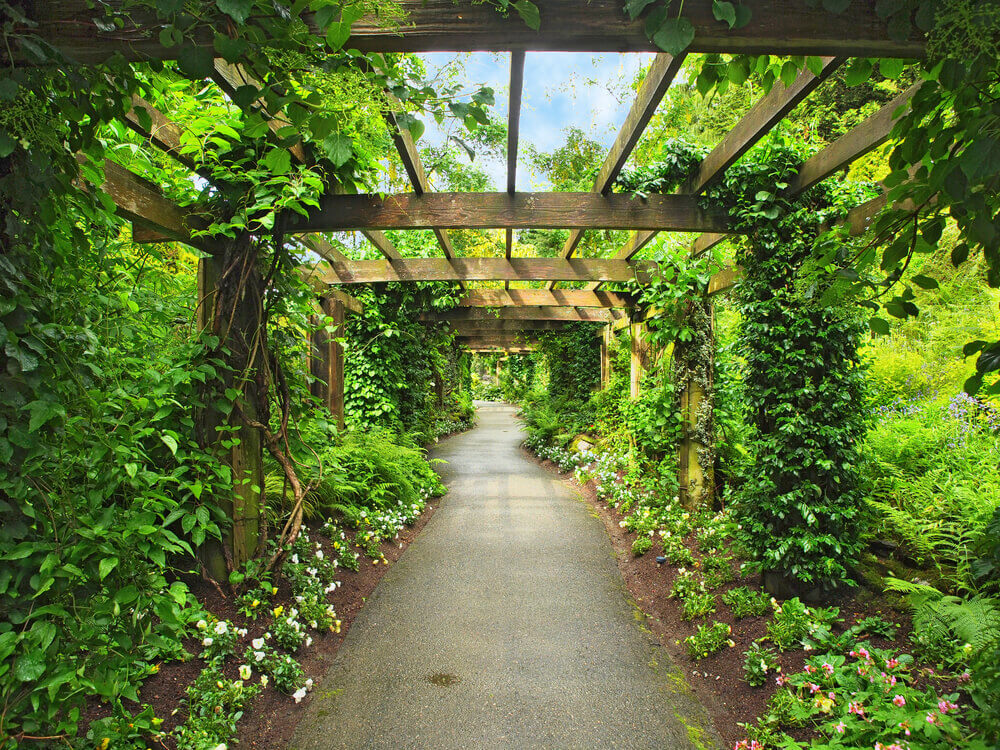Pergolas - Backyard Havens

Pergolas are simple structures that use a system of horizontal beams that sit on top of pillars. Simple, right?
You can install them in many places. For example, pergolas can sit close to homes, in a backyard entrance, on the perimeter or in the middle of a pathway.
You can also arrange climbing plants to grow on them. When they cover the posts and beams, the plants can create nice, cool shade.
Shady refuges

Being roofed structures, pergolas make the ideal haven to hide away from strong winds and direct sunlight.
Thus, they’re an ideal place to set up an outdoor dining table. You can also use them to create a reading corner or a shady spot next to a pool.
Style and size
Just as other vertical structures are arches, pergolas should fit the decor style of their surroundings.
They should also be proportional to the size of the backyard it stands in. Also, try to avoid overloading with flower baskets as excessive decor can create a feeling of chaos.
Minimal maintenance

Take care of your wood by applying a coat of colorless varnish every 3-5 years. The varnish will help the wood stand the test of time.
Or, if you want to save yourself the maintenance chores, look for aluminum models instead.
The best materials for pergolas
Iron models have an extra romantic feeling. But recently, wood and aluminum have been the most popular materials for pergolas.
You can also find stone pillar and wooden beam structures. Another option that’s similar to stone is brick, which can create a more rustic decor.
In any case, wooden structures are the most popular option mainly because they can be installed quickly as well as being relatively lightweight, which makes them easy to work with.
You can find complete pergola kits at home gardening stores. Don’t worry about setting yours up – it’s not complicated.
Perfect pergola plants

Climbing plants, or vines, look beautiful on these structures. They have long, winding stems that decorate perfectly.
In the climbing plant family, some species are quire delicate while others are just the opposite but they all share the ability to climb, which creates a wild, natural decor.
Climbing plants with a sturdier stem, such as honeysuckle or wisteria, make great options. Delicate plants, however, like clematis can also look beautiful with their varied shapes and colors.
Installing a pergola
Before you set up your structure, make sure you have enough space for it. If it ends up being too big, it’ll take away from all the other elements in your backyard.
Make sure you install it securely and that the structure can withstand wind. The structure’s security will depend on its stability.
Also, keep in mind that some companies offer custom-made products. But if you think you can build yours yourself, check out the steps to make it happen. It’s not that difficult at all!
- Dig holes about 10 cm into the ground and stick in the posts. After, fill with cement.
- Make sure that the posts stand perpendicularly to the floor.
- Set up the middle posts before screwing in the beams.
- Screw the supporting struts to the beams. Make sure they’re evenly spaced apart.
And these are the materials that you’ll need:
- Wood posts.
- Long nails.
- Cement.
- Screw nails.
- Electric screwdriver.
- Hammer.
- Screwdriver.
- Bubble level.
- Ladder.
And make sure that your pergola doesn’t exceed your home in height. It should look proportional and balanced. Time to get to work!
Pergolas are simple structures that use a system of horizontal beams that sit on top of pillars. Simple, right?
You can install them in many places. For example, pergolas can sit close to homes, in a backyard entrance, on the perimeter or in the middle of a pathway.
You can also arrange climbing plants to grow on them. When they cover the posts and beams, the plants can create nice, cool shade.
Shady refuges

Being roofed structures, pergolas make the ideal haven to hide away from strong winds and direct sunlight.
Thus, they’re an ideal place to set up an outdoor dining table. You can also use them to create a reading corner or a shady spot next to a pool.
Style and size
Just as other vertical structures are arches, pergolas should fit the decor style of their surroundings.
They should also be proportional to the size of the backyard it stands in. Also, try to avoid overloading with flower baskets as excessive decor can create a feeling of chaos.
Minimal maintenance

Take care of your wood by applying a coat of colorless varnish every 3-5 years. The varnish will help the wood stand the test of time.
Or, if you want to save yourself the maintenance chores, look for aluminum models instead.
The best materials for pergolas
Iron models have an extra romantic feeling. But recently, wood and aluminum have been the most popular materials for pergolas.
You can also find stone pillar and wooden beam structures. Another option that’s similar to stone is brick, which can create a more rustic decor.
In any case, wooden structures are the most popular option mainly because they can be installed quickly as well as being relatively lightweight, which makes them easy to work with.
You can find complete pergola kits at home gardening stores. Don’t worry about setting yours up – it’s not complicated.
Perfect pergola plants

Climbing plants, or vines, look beautiful on these structures. They have long, winding stems that decorate perfectly.
In the climbing plant family, some species are quire delicate while others are just the opposite but they all share the ability to climb, which creates a wild, natural decor.
Climbing plants with a sturdier stem, such as honeysuckle or wisteria, make great options. Delicate plants, however, like clematis can also look beautiful with their varied shapes and colors.
Installing a pergola
Before you set up your structure, make sure you have enough space for it. If it ends up being too big, it’ll take away from all the other elements in your backyard.
Make sure you install it securely and that the structure can withstand wind. The structure’s security will depend on its stability.
Also, keep in mind that some companies offer custom-made products. But if you think you can build yours yourself, check out the steps to make it happen. It’s not that difficult at all!
- Dig holes about 10 cm into the ground and stick in the posts. After, fill with cement.
- Make sure that the posts stand perpendicularly to the floor.
- Set up the middle posts before screwing in the beams.
- Screw the supporting struts to the beams. Make sure they’re evenly spaced apart.
And these are the materials that you’ll need:
- Wood posts.
- Long nails.
- Cement.
- Screw nails.
- Electric screwdriver.
- Hammer.
- Screwdriver.
- Bubble level.
- Ladder.
And make sure that your pergola doesn’t exceed your home in height. It should look proportional and balanced. Time to get to work!







